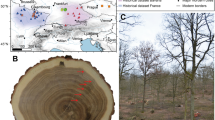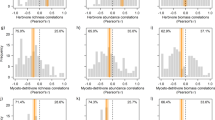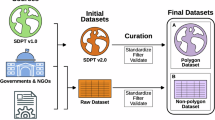Abstract
Major controversies have erupted in recent years about extensive and intensive timber harvesting programs in Tasmania and the U.S. Pacific Northwest. These conflicts have centered on ecological impacts and both regions have responded by adopting similar programs of “ecological forestry.” Both programs emphasize the retention of varying amounts of trees in aggregated or dispersed patterns within harvests, and seek to “life boat” mature-forest habitat functions across some harvest prescriptions. Are these programs garnering similar public acceptance? Do people with similar ideologies judge the acceptability of forests similarly in both regions? Do perceptions differ between regions due to differences in ecological, cultural or economic conditions? Similar public perception surveys within each region investigated the acceptance of harvest prescriptions that matched closely between regions. In both surveys, images of the appearance of harvests were presented to respondents with expert-derived information about the magnitude of similar ecological, safety and economic impacts. Respondents rated the acceptability of each prescription. Respondents’ environmental attitudes were classified as forest protectionist, productionist or non-aligned within each region. Statistical and graphical analyses compared the patterns and sources of comparable acceptability judgments between the regions.
Results/Conclusions
Ideologically similar samples of respondents in both regions exhibited comparable patterns of increasing mean acceptability ratings with increasing tree retention levels for all harvest prescriptions, except 30-40% dispersed retention harvests. These comparable respondent samples also exhibited similar correlations between acceptability ratings and levels of harvest impacts by category, exhibiting the same associations between ideologies and preferred impacts across regions. Three exceptions showed that Tasmanians exhibited a greater range of sensitivity for certain impact categories: (1) ground habitat impacts, likely attributable to greater retention of down wood in all Pacific Northwest prescriptions, versus burning most down wood in some Tasmanian prescriptions for regeneration of commercial species; (2) logger safety, likely attributable to greater differences in actual safety levels across the Tasmanian prescriptions; and (3) wildfire risk, likely because the affected Pacific Northwest region has few historical wildfires. Utility functions were estimated for each region’s respondents and applied to the opposite region’s forests. This confirmed that both regions’ respondents would agree about the lower acceptability of Tasmanian 30-40% dispersed retention harvests, likely because Tasmanians retain only a percent of commercial species while felling all other trees, versus Americans’ retention of a percent of all tree types, retaining more trees and more ecosystem components.
Similar content being viewed by others
Article PDF
Author information
Authors and Affiliations
Corresponding author
Rights and permissions
About this article
Cite this article
Ribe, R., Ford, R. & Williams, K. Comparing and Explaining Public Acceptance Of Ecological Forestry in Tasmania and the U.S. Pacific Northwest . Nat Prec (2009). https://doi.org/10.1038/npre.2009.3744.1
Received:
Accepted:
Published:
DOI: https://doi.org/10.1038/npre.2009.3744.1
Keywords
This article is cited by
-
Stakeholder perspectives on the value proposition of enterprise-level natural capital accounting for three primary industries
Environment Systems and Decisions (2021)



